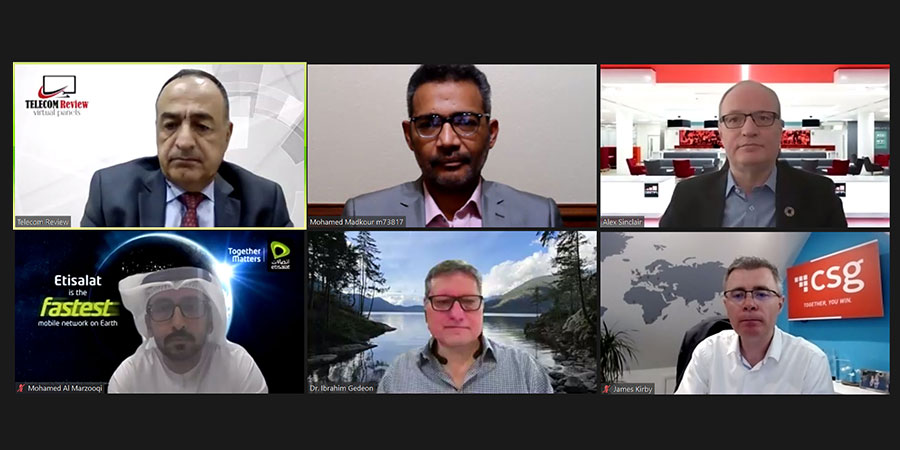In the framework of Telecom Review’s virtual panel entitled “Beyond 5G: Endless benefits of 5G to operators”, moderator and Telecom Review Group CEO Toni Eid has asked the panelists about what is the next step to secure return on investment (ROI) as operators are known to have heavily invested in 5G.
In a nutshell, 5G investments are still in their early stage and there are a lot of factors and business use cases to consider. To make the most out of the money being spent, fostering usage, filling the gap, leveraging business, ensuring consistency in operations, and improving the network must be the end goals.
Telcos must invest now and become enablers
Mohamed Al Marzooqi, VP Technology Synergies at Etisalat Group thinks that despite the perspective of stakeholders that telcos have invested a lot on 5G, the investments being done until now are just the “tip of the iceberg.” He anticipates that only in the next two to three years will more significant investments come up.
Along with this, he highlighted that not only investment in the spectrum, licensing, and base centers will generate a lot of money but also integrated services on artificial intelligence (AI), slicing, big data, quality of service (QoS), machine-to-machine (M2M) communication, cloud networking, and blockchain. “We as an operator need to be ready and we need to invest in the beginning to be able to monetize whatever investment will be done in these fields.”
James Kirby, SVP & Head of EMEA Business at CSG also specified that despite having large 5G investments in the network and RAN-side of the rollout, one of the ways of maximizing the ROI is to get the people to use it. In this case, operators must change the ways of how they do their business.
For James, there’s a gap among operators as they focus too much on putting up the masts and waiting for clients to show up. “As we look at the more complex business models, there’s an integration activity that is needed. For operators that do go beyond sticking up the masts, they actually have the capability for system integration or communication integration where they actually enable the enterprises to come on board with these new business models. I think that can actually speed up the return on the investments.” He pointed out that failing to be enablers may cause operators to lose some money.
5G is a catalyst but transformation is the key
In his point of view, TELUS CTO Dr. Ibrahim Gedeon relates 5G investments to edge deployment, considering the larger and more beneficial scope. “Before we talk about monetization, I think for the first time in our life, the challenge is more than just RAN.” He mentioned that traditional radio access network (RAN) coverage is already very important for 4G. But with the current data demand, the fiber infrastructure that comes along with it becomes more essential.
He further added that in a typical city, citing Edmonton as an example that has 10,000 sqkm with a million and a half people, the old way of thinking would be to deploy at least 5 mobile edge computing (MEC) tiny data centers only. But in reality, to cater to the amount of data within stadiums and companies around the area, around 100 edges/cores should be deployed. This will be the challenge, Ibrahim said.
In terms of use cases, transportation and agriculture, among others, must leverage the existence of 5G technology. Otherwise, the purpose behind it hasn’t been fulfilled. “Everybody will try it as an experiment...but if it will not be a part of their transformation and replacing what they do today, it’s good for a press release.”
GSMA CTO Alex Sinclair agrees that “there’s a lot more than RAN these days.” Based on the recent data they gathered, 83% think that the majority of the ROI will come from enterprises and government applications. While public services, healthcare, and education are also considered. Something that they expect to be lucrative as well are manufacturing, mining, retail, utilities, and cloud gaming.
“The real problem is scaling all of these things.” Similar to Ibrahim’s take on the subject, Alex thinks that unless there’s a real use case or application that shows scalability, the efficacy can’t be proved.
Following this, Dr. Mohamed Madkour, VP Global Wireless Networks Marketing and Solutions at Huawei shared three dimensions that should be prioritized to be able to shorten the time needed for ROI. These are the business, operational, and network/technical aspects.
For business, he cited the two major events coming up in the Middle East — Expo 2020 and World Cup 2022. In this case, OTTs and premium applications would come up with tactics like smart shopping, 5G broadcasting, and playbacks. On the operational side, continuous investment in digital transformation is crucial. Additionally, Huawei came up with a new ‘5G Experience Benchmark’ that includes three main indexes: speed, latency, and availability (SLA). By using the S*L*A formula, precise investment and improved user experience can be guaranteed.
Interestingly, Marzooqi brought up the question of 5G being an “evolution or a revolution.” He said that being a part of the older generation, it is a revolution as he witnessed the 2G and 3G eras. Yet, for the young generation, the speed and low latency seem only an evolution.











